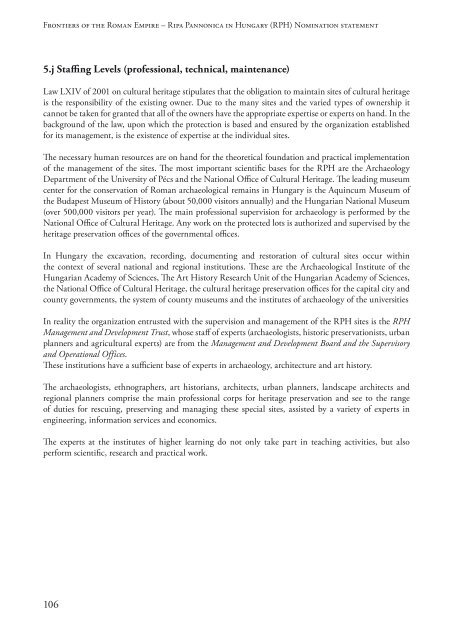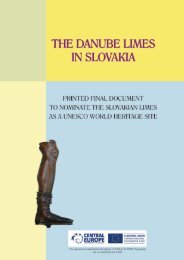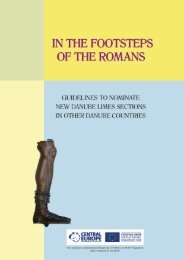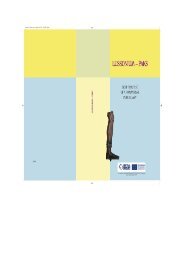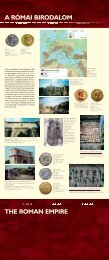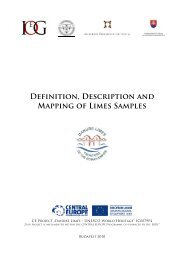the PDF version! - Danube Limes
the PDF version! - Danube Limes
the PDF version! - Danube Limes
You also want an ePaper? Increase the reach of your titles
YUMPU automatically turns print PDFs into web optimized ePapers that Google loves.
Frontiers of <strong>the</strong> Roman Empire – Ripa Pannonica in Hungary (RPH) Nomination statement<br />
5.j Staffing Levels (professional, technical, maintenance)<br />
Law LXIV of 2001 on cultural heritage stipulates that <strong>the</strong> obligation to maintain sites of cultural heritage<br />
is <strong>the</strong> responsibility of <strong>the</strong> existing owner. Due to <strong>the</strong> many sites and <strong>the</strong> varied types of ownership it<br />
cannot be taken for granted that all of <strong>the</strong> owners have <strong>the</strong> appropriate expertise or experts on hand. In <strong>the</strong><br />
background of <strong>the</strong> law, upon which <strong>the</strong> protection is based and ensured by <strong>the</strong> organization established<br />
for its management, is <strong>the</strong> existence of expertise at <strong>the</strong> individual sites.<br />
The necessary human resources are on hand for <strong>the</strong> <strong>the</strong>oretical foundation and practical implementation<br />
of <strong>the</strong> management of <strong>the</strong> sites. The most important scientific bases for <strong>the</strong> RPH are <strong>the</strong> Archaeology<br />
Department of <strong>the</strong> University of Pécs and <strong>the</strong> National Office of Cultural Heritage. The leading museum<br />
center for <strong>the</strong> conservation of Roman archaeological remains in Hungary is <strong>the</strong> Aquincum Museum of<br />
<strong>the</strong> Budapest Museum of History (about 50,000 visitors annually) and <strong>the</strong> Hungarian National Museum<br />
(over 500,000 visitors per year). The main professional supervision for archaeology is performed by <strong>the</strong><br />
National Office of Cultural Heritage. Any work on <strong>the</strong> protected lots is authorized and supervised by <strong>the</strong><br />
heritage preservation offices of <strong>the</strong> governmental offices.<br />
In Hungary <strong>the</strong> excavation, recording, documenting and restoration of cultural sites occur within<br />
<strong>the</strong> context of several national and regional institutions. These are <strong>the</strong> Archaeological Institute of <strong>the</strong><br />
Hungarian Academy of Sciences, The Art History Research Unit of <strong>the</strong> Hungarian Academy of Sciences,<br />
<strong>the</strong> National Office of Cultural Heritage, <strong>the</strong> cultural heritage preservation offices for <strong>the</strong> capital city and<br />
county governments, <strong>the</strong> system of county museums and <strong>the</strong> institutes of archaeology of <strong>the</strong> universities<br />
In reality <strong>the</strong> organization entrusted with <strong>the</strong> supervision and management of <strong>the</strong> RPH sites is <strong>the</strong> RPH<br />
Management and Development Trust, whose staff of experts (archaeologists, historic preservationists, urban<br />
planners and agricultural experts) are from <strong>the</strong> Management and Development Board and <strong>the</strong> Supervisory<br />
and Operational Offices.<br />
These institutions have a sufficient base of experts in archaeology, architecture and art history.<br />
The archaeologists, ethnographers, art historians, architects, urban planners, landscape architects and<br />
regional planners comprise <strong>the</strong> main professional corps for heritage preservation and see to <strong>the</strong> range<br />
of duties for rescuing, preserving and managing <strong>the</strong>se special sites, assisted by a variety of experts in<br />
engineering, information services and economics.<br />
The experts at <strong>the</strong> institutes of higher learning do not only take part in teaching activities, but also<br />
perform scientific, research and practical work.<br />
106


